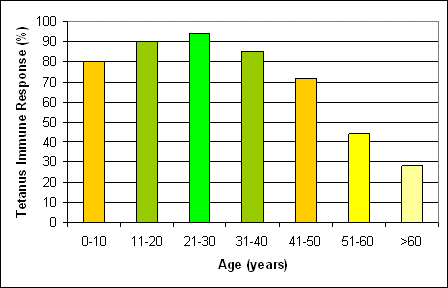Current Treatments and Future Directions
Available Treatments
A variety of treatments are available for combating the effects of tetanus. Penicillin is used commonly around the globe, and can be ingested intramuscularly or intravenously for 7 to 10 days at a dose of 100,000 – 200,000 IU/kg/day. However, it is believed that penicillin can compete with the neurotransmitter g-aminobutyric acid (GABA) which acts as an inhibitor of motor neuron function. As a result, some patients who are treated with penicillin may experience negative side effects, such as convulsions (Farrar et al., 2000).
Nowadays, safer alternatives are available for treatment, such as metronidazole. In a study by Yen et al. (1997), tetanus patients treated with metronidazole needed fewer muscle relaxants than those treated with penicillin. Metronidazole can be administered in 400-mg doses, or intravenously, for 7-10 days. If this particular drug is not available, then other alternatives can be used, such as erythromycin, tetracycline, vancomycin, clindamycin, doxycyclidine, and chloramphenicol (Farrar et al., 2000).
Other Considerations
Muscular spasms resulting from infection with tetanus can cause airway obstruction and hypoventilation; as a result, respiratory failure is a common cause of death for tetanus patients around the world. It is important to provide patients with adequate ventilatory support in this situation. In addition, a percutaneous tracheostomy can be performed on patients to alleviate respiratory difficulty (Farrar et al., 2000).
Vaccination with Tetanus Toxoid
Immunization with human or equine tetanus toxoid can help to reduce the severity of a tetanus infection. Additionally, neonatal tetanus can be prevented if the mother is immunized two or three times during pregnancy. Reactions to tetanus toxoid are infrequent, and occur in about 1 in 50,000 patients.
In the United States, most patients who suffer from tetanus infection are over 50 years old and unvaccinated. In individuals who have been vaccinated, the concentration of anti-tetanus toxoid antibody begins to drop dramatically around age 40, and continues to drop to 30-percent of its peak value by age 60 (Figure 1). For those who are vaccinated in early childhood, the cellular immune response to the toxin is highest during the first 30 years of life (80-96% response). Such results indicate that early vaccination is advantageous, and that it may be beneficial to receive tetanus “booster” shots every 10 years (Schatz et al., 1998).
 |
Figure 1. Frequency of cellular immune response at various ages. Adapted from Schatz et al., 1998. |
This web page was produced as an assignment for an undergraduate course at
Davidson College.
Contact: cahermes@davidson.edu